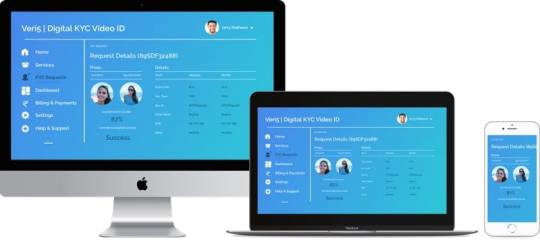Veri5Digital was started by Saru Tumuluri in 2016. It is an attempt to build identity technology around Aadhaar’s digital signatures, KYC, and video KYCs. https://www.veri5digital.com/
Don't wanna be here? Send us removal request.
Text

Aadhaar eSign API is a digital signature solution that simplifies the signing process by replacing physical signatures with electronic ones. It offers a secure and convenient way to sign documents using OTP or biometric authentication. The API supports various document types, verification methods, and deployment models, making it a versatile tool for businesses of all sizes.
0 notes
Text
The Importance of Aadhaar Masking Solution for Data Privacy
The Aadhaar, a unique number given to the residents of India, offers to be a source of verification and authentication for name, date of birth, and address. Thus, a twelve-digit number is unique to every single individual and provides a strengthened source to get the information for verification. But is it safe to share this number with everyone? The answer is an absolute no; therefore, we need Aadhaar masking. Understanding the concept and the need to incorporate it is what we are going to discuss in this blog.
Understanding Aadhaar masking
The process of obfuscating or concealing a sizable chunk of the Aadhaar number—typically the first eight digits—while keeping the final four digits for identifying purposes is known as Aadhaar masking. This method finds a middle ground between safeguarding sensitive personal data and the requirement for verification.
The need for Aadhaar masking for data privacy
Aadhaar masking offers a number of advantages, especially safeguarding crucial information against misuse and fraud. Here are the points summed up:
Preventing Identity Theft: Aadhaar's complete number has a plethora of personal data. It is much more difficult for bad actors to steal identities and commit fraud when the first eight numbers are hidden.
Reducing Data Breaches: Data breaches can still happen even in the presence of strong security measures. By making the masked component of the number less desirable to attackers, masking Aadhaar numbers reduces the potential damage in the event of a breach.
Compliance with Data Protection Regulations: As more stringent laws are implemented, India's data protection environment is changing. By complying with these rules, Aadhaar masking shows a dedication to data privacy.
Establishing Trust: Businesses can establish trust with their clients by utilising Aadhaar masking to reassure them that their personal data is secure.
Safeguarding Financial Data: Financial transactions are frequently associated with Aadhaar. An additional degree of security is added to protect sensitive financial data by masking the Aadhaar number.
Technologies involved in Aadhaar masking solutions
Technology is essential to Aadhaar masking that works. Sophisticated masking techniques can automate the procedure, guaranteeing efficiency and precision. Among the crucial technologies are:
Tokenisation is the process of swapping out sensitive data for non-sensitive tokens.
Aadhaar data is encrypted to prevent reading without the decryption key.
Software for disguising sensitive data, such as Aadhaar numbers, is known as data masking software.
Best practices for Aadhaar masking online
To maximise the effectiveness of Aadhaar masking, the following actions should be implemented by the organisations:.
Put Strong Security Measures in Place: To protect data, organisations need to have strong security measures in place in addition to Aadhaar masking.
Frequent Security Audits: To find weaknesses and put in place the appropriate defences, conduct routine security audits.
Employee Education: Educate staff members on the value of protecting personal information and how to handle Aadhaar data appropriately.
Data Minimisation: Gather just the bare minimum of Aadhaar data and store it for as little time as feasible.
Constant Surveillance: Keep an eye out for any indications of unapproved access to Aadhaar data or data breaches.
Regulations and Aadhaar masking guidelines
UIDAI mandates: The main regulatory agency in charge of regulating Aadhaar and its use is the Unique Identification Authority of India (UIDAI).
RBI instructions: With relation to Aadhaar masking, the Reserve Bank of India (RBI) has provided particular rules for banks and financial institutions.
Industry-specific rules: Aadhaar processing is governed by regulations related to other industries, such as telecom, insurance, and healthcare.
Data Protection Act: Aadhaar masking and data privacy would probably be covered under India's soon-to-be-enacted Data Protection Act.
Masking standards: Standards for masking Aadhaar numbers have been established by UIDAI. These standards cover the arrangement and structure of masked digits.
Compliance requirements: In order to avoid fines, organisations that handle Aadhaar data must abide by certain rules and laws.
ConclusionIn conclusion of the blog on aadhaar masking, we can say that the process is of paramount importance, and with proper knowledge and following regulations, data privacy can be ensured. With the right compliance practices and following the prescribed guidelines, it is easy to meet the masking guidelines. Veri5digital is another such platform to get your business’s authentication and verification processes done. Visit their website to learn more about their services.
0 notes
Text
0 notes
Text
0 notes
Text
What are the top 5 things under Aadhaar Masking guidelines?
The way we authenticate ourselves for a range of services has entirely changed thanks to Aadhaar, India's national identity number. However, given the increase in data breaches and privacy concerns, it is now imperative to protect sensitive personal data. To address this, the Unique Identification Authority of India (UIDAI) introduced Aadhaar masking. This blog examines the top five topics addressed by the Aadhaar masking regulations, providing details on the process, benefits, and implementation issues.
Unlocking the process of Aadhaar masking

An added layer of security called Aadhaar masking keeps your complete Aadhaar number hidden from prying eyes. It means that only the final four digits of the Aadhaar number are displayed, with the first four being hidden. This method ensures that sensitive data is protected while allowing for basic verification.
The top 5 things under Aadhaar masking guidelines
The top five things that come under the umbrella of Aadhaar masking guidelines are as follows:
Purpose-based masking: Aadhaar masking should only be used to achieve specific, legal goals including authentication, verification, and restricted information transmission. Unauthorised disclosure or use of masked Aadhaar numbers is strictly prohibited.
Data minimisation: The Aadhaar number should only be used when it is absolutely essential for the intended purpose, according to this concept. Giving away the complete masked Aadhaar number without a valid reason is prohibited by law.
Security and privacy: Organizations that handle masked Aadhaar numbers must adhere to stringent security guidelines to prevent data breaches and unauthorised access. Strong encryption and access controls must be included.
Customer consent: Aadhaar holders must give their express approval before collecting, retaining, or disclosing disguised Aadhaar numbers. Open communication regarding the purpose and application of the hidden data is crucial.
Regular inspections and adherence: Regular audits are necessary for entities handling Aadhaar data, including masked Aadhaar numbers, to ensure compliance with the Aadhaar Act and related legislation. Failure to comply may have dire consequences.
Working on Aadhaar masking API
To properly deploy Aadhaar masking, entities can use the Aadhaar Masking Application Programming Interface (API) provided by UIDAI. This API makes it simple to integrate the Aadhaar masking functionality into a range of systems and apps. Some of the primary characteristics of the Aadhaar masking API include:
Real-time masking: Aadhaar numbers are instantaneously concealed as soon as data is entered.
Secure transmission: To protect personal data, encryption is used during data transfer.
Error management: robust error-handling protocols are implemented to address API malfunctions.
Technical support: comprehensive API integration documentation is offered.
Is an Aadhaar masking solution worth it?
There are various advantages to implementing the Aadhaar masking solution. Here is a detailed description of all the advantages offered.
Enhanced security: protects Aadhaar holders from fraud and identity theft.
Compliance observance: Ensures compliance with data protection regulations.
Consumer confidence: By safeguarding personal information, consumers' confidence is increased.
Risk mitigation: reduces the likelihood of data breaches and the potential financial and reputational damage they may bring about.
Nevertheless, it's essential to thoroughly weigh the benefits and drawbacks before purchasing an Aadhaar masking solution. Things like the nature of the organization, the volume of Aadhaar data handled, and the required level of security should all be taken into account.
Conclusion
Adhaar masking is a crucial first step in safeguarding the security and privacy of Adhaar holders. By understanding the top five items covered by the Aadhaar masking rules and utilizing the Aadhaar masking API effectively, entities may maintain the value of Aadhaar for authentication and verification while protecting sensitive data. As the digital ecosystem continues to evolve, organizations that use Aadhaar data need to be aware of the best practices and criteria for Aadhaar masking.
Veri5digital offers a wide range of digital solutions to businesses in order to enhance the efficiency of what they do best. Aadhaar masking is one such service, with many others to explore. Visit their website to learn more about their offerings.
0 notes
Text
How Indian businesses can go paperless with e-signatures
Indian firms are realizing that they increasingly need to adopt sustainable practices in today's technologically driven and ecologically sensitive society. Despite their legacy, paper-based operations have a major role in environmental issues like as deforestation and overflowing landfills. Fortunately, e-signature technology has become a game-changer, enabling companies to do away with paper contracts, agreements, and other important paperwork. This blog discusses the many advantages e-signatures provide Indian organizations, looks into the laws governing their usage, and offers guidance on how to make the switch to paperless transactions go smoothly.
Benefits of incorporating digital e-signature

E-signatures have several advantages that simplify business processes, in addition to the obvious environmental benefit of reducing paper use:
Increased Productivity: The days of laborious document distribution and postal mail delays are long gone. Real-time approvals and quicker processes are made possible by the accelerated signing procedure provided by e-signatures.
Streamlined Collaboration: With e-signatures, distance is no longer a barrier to communication. Electronic signatures and easy document sharing allow for smooth teamwork and cross-location communication.
Lower Expenses: With e-signatures, businesses can save a lot of money because they don't need paper, printing, or storage. There is a reduction in the amount of physical storage space needed and the stress of handling piles of documents.
Enhanced Security: The days of lost paperwork and illegal changes are long gone. Strong encryption methods are used by e-signatures to guarantee document integrity, adding another degree of protection against tampering.
Disaster Recovery: Digital papers are easily backed up and recoverable in the event of unanticipated disasters, unlike physical documents that are vulnerable to harm or loss. Your company continuity can no longer be disrupted by a fire or flood.
Encountering the legal landscape of e-signature in India
With the legal recognition provided by the Information Technology Act (2000) and the Aadhaar (Targeted Delivery of Financial and Other Subsidies, Benefits and Services) Act (2016), Indian enterprises can adopt e-signatures with confidence. The two main e-signature options recognized under the statute are:
Digital Signature Certificates (DSCs): Licensed certifying authorities issue DSCs, which provide the highest level of security and are perfect for extremely sensitive documents and high-value contracts.
Aadhaar e-Sign: This approachable solution is appropriate for low-risk documents and makes use of the Aadhaar framework for authentication.
Choosing the best e-signature solution
There are a lot of e-signature options available in the Indian market; therefore, choosing the best one needs careful consideration:
Security Features: To protect sensitive data and guarantee document integrity, give top priority to a solution with strong encryption and tamper-proof methods.
Compliance: Confirm that the solution complies with all applicable Indian laws pertaining to data protection and e-signatures. Adherence to the Information Technology Act and its subsequent revisions is crucial.
User-Friendliness: The importance of an interface cannot be overstated. Regardless of technical proficiency, choose a platform that easily fits into your current workflows and is user-friendly for all staff members.
Scalability: Take future expansion into account. Select a solution that can grow with your company to meet your changing demands, making sure it can manage a growing number of users and documents.
Cost-Effectiveness: Compare the features and pricing structures provided by various suppliers. Look for a solution that fits your budget and provides the features your company needs.
A guide to help you go paperless
Making the switch to an e-signature paperless process necessitates planning ahead. Here is a detailed guide to assist you in navigating the procedure:
Create an e-Signature Policy: Clearly define the policies that govern the use of e-signatures in your company. The kinds of papers that can be e-signed, the signature authorization process, and the dispute resolution procedures in the event of a discrepancy should all be outlined in this policy.
Train Staff: Give your staff thorough training on the features and advantages of e-signatures. Make sure that everyone is aware of the new procedure and is at ease utilizing it.
Choose an e-Signature Supplier: Make sure the supplier fits your budget and unique demands by doing extensive research and selecting one that is reliable. When selecting your decision, take into account aspects like scalability, usability, and security features.
Integrate with Current Systems: For maximum effectiveness, make sure the e-signature solution works in unison with your current workflow and document management systems. This speeds up the signature procedure and does away with the necessity for human data entry.
Begin Small and Expand: Start with a small number of documents, such as non-disclosure agreements or internal memos, and e-sign them. After workers feel at ease with the procedure, you can progressively broaden its scope to include all of your workflows.
The future of digital e-signature
Indian enterprises will definitely operate paperless in the future. The following significant developments support the widespread use of e-signatures:
Growing Environmental Consciousness: Organizations and customers alike are becoming more conscious of how using paper affects the environment. E-signatures present a strong substitute that fits in with expanding sustainability standards and helps create a greener future.
Advanced Security Features: Multi-factor authentication and biometric signing choices are just two examples of the advanced security features that e-signature companies are constantly adding to their offerings. This will improve adoption and trust in the business environment even more.
Integration with Artificial Intelligence (AI): By automating risk assessments, optimizing document workflows, and spotting any fraud attempts, AI has the ability to completely transform e-signatures. AI integration will increase the efficiency and security of e-signatures.
Global Standardization: As e-signatures become more popular worldwide, attempts are being made to create worldwide guidelines for legal recognition and interoperability. This will speed up the adoption of e-signatures and enable smooth cross-border transactions.
Conclusion
Adopting e-signatures offers Indian companies a win-win scenario. They have numerous operational advantages in addition to helping to maintain environmental sustainability. Indian firms may lead the path toward a paperless future by comprehending the legal environment, selecting the best course of action, and putting a strategic plan into action. With the backing of the government and future technological developments, e-signatures are set to become the backbone of safe and effective corporate transactions in India.
Visit Veri5Digital if your company is searching for a dependable platform for digital solutions such as Aadhaar masking, video KYC procedures, and many more. They provide you with an interactive interface and efficient services to assist you grow your business to new heights.
0 notes
Text

Veri5 Digital's Verification APIs streamline your processes! Our secure solutions integrate seamlessly, verify identities effortlessly, and minimize fraud risks. Boost efficiency, enhance customer experience, and focus on growth - Contact Veri5 Digital today!
0 notes
Text

Veri5 Digital's Digital KYC Solutions provide a secure and streamlined approach. Reduce onboarding time, ensure regulatory compliance, and minimize fraud risks.
0 notes
Text
0 notes
Text
0 notes
Text
eNACH e-mandate: Everything You Must Know
It might be difficult to keep track of regular payments in the fast-paced world of today. It might be difficult to keep track of deadlines, input payment details multiple times, and worry about incurring late fees. Thankfully, the ENACH mandate, a ground-breaking solution, has been adopted by the Indian financial sector.
This blog delves deeply into all the information you require concerning the NACH e-mandate, enabling you to make wise choices and have a more seamless payment process.
Knowledge of the abbreviations

Bulk bank account transfers are made possible in India by the National Automated Clearing House, or NACH, a payment processing system.
An electronic mandate, or e-mandate, is a written consent that permits a company or organization to take a predetermined amount out of your bank account.
What is ENACH?
The National Payments Corporation of India (NPCI) created the NACH e-mandate as an electronic framework to make recurring payments easier. It gives people the ability to authorize automatic withdrawals from their bank accounts for several purposes, such as:
Loan EMIs: Easily repay loans in installments on time.
Insurance Premiums: By paying premiums automatically, you can guarantee continuous insurance coverage.
Subscription Fees: This takes away the chance of forgetting when your subscription is set to renew.
Utility Bills: Water, power, and other utility bill payments are certain to be made on schedule.
Mutual Fund Investments: Investing in mutual funds allows for hassle-free Systematic Investment Plans (SIPs).
A synopsis of e-mandate vs ENACH Mandate
There is a subtle distinction between the phrases "e-mandate" and "NACH mandate," despite their frequent interchangeability.
NACH mandate: A more general word that refers to the permission for NACH system-based credit and debit transactions.
e-Mandate: This especially describes the electronic consent for debit transactions that occur on a regular basis.
How do you use the NACH e-mandate?
Three entities work together seamlessly to complete the NACH e-mandate process:
Customer: The person authorizing the automatic deductions.
Service Provider: The entity or institution receiving the payments is known as the service provider (e.g., bank, insurance company, utility provider).
Bank: The company that manages the customer's bank account.
This is a condensed explanation of the procedure:
Customer Initiates: Through the service provider's mobile application or web portal, the customer grants permission for automatic payments to be made regularly.
e-Mandate Request: The National Payments Corporation of India (NPCI) receives the customer's e-mandate request from the service provider.
Bank Verification: The request is safely forwarded to the customer's bank via NPCI for verification.
Authorization: The bank attaches the e-mandate to the customer's account after successful verification, approving recurrent debits.
Automated Payments: After that, on scheduled dates, the service provider starts taking money out of the client's account following the directive.
NACH e-Mandate advantages:
Convenience: By automating recurring payments, manual intervention and the possibility of missing deadlines are avoided.
Decreased Paperwork: Makes record-keeping easier and does away with the need for physical mandates.
Time-Saving: prevents people from having to keep track of several transactions and payment dates.
Better Cash Flow Management: Companies may guarantee that payments are received on schedule, which will improve their financial stability.
Decreased Operational Costs: This decreases the administrative costs related to processing payments by hand.
Qualifications for the ENACH mandate process:
People have to fulfill certain requirements to use the NACH e-mandate:
Bank Account: Keep a current or savings account with a bank that uses the NACH e-mandate system.
Aadhaar Card: Possess a current Aadhaar card that is connected to their bank account.
Mobile Number: Keep your cell number up to date so that you can receive permission notifications from both the bank and your Aadhaar card.
Security measures:
The NACH e-mandate places a high priority on these elements.
Two-Factor Authentication: This method of authorization uses safe techniques such as one time passwords.
End-to-end Encryption: This technique uses encryption techniques to protect private client data.
Dispute Resolution Mechanism: A foundation for resolving any inconsistencies or unlawful transactions is provided by the dispute resolution mechanism.
Conclusion
In India, the world of recurring payments has completely changed because of the ENACH mandate. It empowers people as well as organizations by providing an automated, safe, and simple solution. The increasing uptake of e-mandates creates the conditions for a financial ecosystem that is more organized and productive.
Do you need assistance adjusting to the digital age? Modern solutions from Veri5digital may streamline business operations, boost output, and facilitate corporate growth. To achieve your full digital potential, get in touch with them right now!
FAQs
When using the ENACH mandate for periodic payments, are there any costs involved?
The NACH e-Mandate framework does not charge any transaction fees to clients; however, banks or other financial institutions may charge small administrative costs for establishing the mandate. If there are any costs or charges related to NACH e-Mandate registration and processing, people or enterprises should check with their specific banks or service providers.
How do people or companies set up NACH e-mandates to be paid regularly?
A few easy steps can be followed by individuals or organizations to set up NACH e-mandates for regular payments:
For information on NACH e-Mandate registration, get in touch with their bank or other financial institution.
Complete the relevant paperwork and include all requested information, including the amount, frequency, and duration of payments, as well as bank account data.
Use your net banking login information or an e-signature based on Aadhaar to authenticate the obligation.
Send the mandate for processing to the bank or other financial organization.
Recurring payments will be automatically deducted from the designated bank account on the dates stated after the mandate is authorized.
What are the advantages for customers and businesses of NACH e-Mandate?
Businesses and customers alike can greatly profit from NACH e-Mandate. Businesses benefit from it in that it expedites the collection of recurring payments, lowers operating expenses related to processing mandates manually, and improves payment processing efficiency. Online setup and management of electronic mandates is convenient for customers since it guarantees on-time bill and subscription payments without requiring personal interaction.
0 notes
Text

Veri5Digital's eSign API offers a secure and convenient solution for replacing wet signatures with Aadhaar-based eSign. This allows businesses in India to streamline their document signing processes and enhance customer experience.
0 notes
Text
0 notes
Text
Demystifying Identity Verification APIs: Speed, Security, and Seamless Onboarding

In today's digital landscape, verifying user identity is crucial for businesses across industries. From financial services to online gaming, ensuring that users are who they claim to be is not just a regulatory requirement, but also a cornerstone of building trust and mitigating fraud. But traditional methods of identity verification can be tedious, time-consuming, and prone to human error.
Enter Identity Verification APIs (IV APIs). These innovative solutions offer a streamlined and automated approach to user onboarding, leveraging cutting-edge technologies like AI and document verification to ensure fast, accurate, and secure identity checks.
This blog dives deep into the world of IV APIs, exploring their benefits, functionalities, and how they can transform your business operations.
Boost Onboarding Speed and Enhance User Experience:
Gone are the days of clunky paperwork and lengthy verification processes. IV APIs enable instant verification of user-submitted documents (ID cards, passports, etc.) through Optical Character Recognition (OCR) and AI-powered algorithms. This significantly reduces onboarding time, leading to a smoother and more engaging user experience. Imagine new users signing up and accessing your services within minutes, not days!
Combating Fraud and Mitigating Risk:
Fraudulent activity can inflict significant financial and reputational damage on businesses. IV APIs act as a powerful shield, utilizing advanced document verification features to detect fraudulent attempts. They can analyze ID authenticity, identify tampered documents, and even perform liveness checks to confirm physical presence during verification. This comprehensive approach safeguards your business from fraudulent actors and ensures regulatory compliance.
Unlocking the Power of Automation:
Manual verification is prone to human error and inconsistencies. IV APIs eliminate this risk by automating the entire process. Once integrated with your existing systems, APIs trigger verification checks seamlessly, freeing up your team to focus on other critical tasks. This automation not only improves efficiency but also ensures consistent and accurate verification across every user interaction.
Key Functionalities of IV APIs:
The capabilities of IV APIs vary depending on the provider, but some of the core functionalities include:
Document verification: Supports diverse document types like ID cards, passports, utility bills, etc.
Data extraction: Accurately extracts key information from submitted documents using OCR.
Liveness checks: Employs facial recognition and movement detection to verify user presence.
Address verification: Confirms user-provided addresses through third-party databases.
Biometric authentication: Uses fingerprints or facial recognition for advanced security.
Regulatory compliance: Ensures adherence to KYC (Know Your Customer) and AML (Anti-Money Laundering) regulations.
Choosing the Right IV API Partner:
Selecting the right IV API partner is crucial for your business success. Here are some key factors to consider:
Security and compliance: Ensure the provider adheres to stringent data security standards and relevant regulations.
Accuracy and reliability: Look for APIs with high accuracy rates and robust fraud detection capabilities.
Integration ease: Choose APIs with simple and well-documented integration procedures compatible with your existing systems.
Scalability and flexibility: Opt for solutions that can adapt to your growing needs and offer diverse verification functionalities.
Cost and pricing: Evaluate pricing models and choose a solution that aligns with your budget and usage requirements.
The Future of Identity Verification:
IV APIs represent a transformative shift in the identity verification landscape. As technology evolves, we can expect even more sophisticated solutions incorporating features like blockchain integration, behavioral analysis, and advanced AI algorithms. By embracing IV APIs, businesses can unlock numerous benefits, including faster onboarding, reduced fraud risk, enhanced user experience, and ultimately, greater efficiency and growth.
Remember, this blog is just a starting point. For a deeper dive into specific features and use cases, explore the resources offered by Veri5Digital, a leading provider of IV APIs in India. With their comprehensive solutions and expertise, you can empower your business with secure, seamless, and future-proof identity verification.
0 notes
Text

In the era of digital transformation, Veri5Digital has pioneered the adoption of Video Customer Identification Process (VCIP) approved by the Reserve Bank of India. With a focus on efficient and secure customer onboarding, Veri5Digital's Video KYC Solution leverages AI to redefine the process
0 notes
Text
Digital Onboarding: Changing The Employee Experience
The custom of the "first day in the office" is becoming less and less common. It involves a ton of paperwork and uncomfortable introductions. A new age of digital onboarding, which seeks to transform the way new hires experience their introduction to the firm, is taking place in enterprises. But as technology advances, new questions often come up, such as whether digital onboarding will actually improve things or if it will simply replace human connection with something cold and impersonal.
Let's explore the realm of digital onboarding, including its effects on the employee experience, benefits, and possible downsides, as well as practical implementation strategies.
The rise of digital onboarding

Uses digital tools and platforms to expedite the onboarding process, driven by technological advancements and changing employee expectations. This frequently entails automating processes like data collection and document signing, doing away with piles of paperwork, and implementing a paperless onboarding suite. Best KYC suites can also confirm employee identities while maintaining security and compliance.
Benefits of digital onboarding solutions
Digital onboarding has advantages for both employers and employees.
For Companies:
Enhanced efficiency: HR departments can save time and costs by automating repetitive operations.
Decreased expenses: Streamlined workflows and paperless procedures reduce administrative expenses.
Enhanced compliance: Electronic signatures and automated document tracking guarantee compliance with laws and regulations.
Faster integration: The learning curve is accelerated for new personnel because they can access information and finish activities at their own pace.
Enhanced employer branding: A cutting-edge, technologically advanced onboarding process presents your business as forward-thinking and alluring to top talent.
For Workers:
Convenience: Utilize any device to access information and complete tasks at any time, anywhere.
Personalized experience: Learning modules and content are designed to meet the needs and preferences of each individual.
Engaging learning: Motivation and retention of knowledge are increased through interactive training.
Increased productivity: Acclimate rapidly and make a significant contribution sooner.
Good first impression: An easy and quick onboarding process creates the foundation for a happy working relationship.
Potential obstacles
But, it's crucial to recognize that there are certain difficulties with digital onboarding as well:
Technology dependency: Employee access to devices and internet connectivity, as well as a dependable technology infrastructure, are necessary for a successful deployment.
Human touch deficit: Although digital technologies might increase productivity, they shouldn't take the place of in-person communication and tailored onboarding assistance for new employees.
Ignoring diversity and inclusion: Digital platforms should be created with inclusion and accessibility in mind, taking into account a range of learning requirements and styles.
Data security and privacy: To safeguard sensitive employee information that is electronically acquired, strong data security procedures are essential.
The future of digital onboarding: a hybrid approach
An effective digital onboarding process depends on finding a balance between technology and interpersonal communication. Think about using a hybrid strategy that combines personal touchpoints with the effectiveness of digital tools. This might consist of:
Individualized welcome calls: staff members or HR professionals getting in touch with recently hired employees.
Virtual mentorship programs: assisting and supporting new hires by matching them with seasoned coworkers.
Social onboarding exercises: promoting online or live team-building exercises.
Feedback mechanism: Reach out to new hires on a regular basis to fix issues and customize their onboarding experience.
Choosing the best digital onboarding solution
There are numerous digital onboarding options that come with different features and functionalities. Think about things like your industry, budget, company size, and particular demands when selecting one. Seek for answers that offer:
Simple to use: Both administrators and new hires will find the interface intuitive.
Customization: The capacity to adjust the onboarding process to the responsibilities and culture of your business.
Integration: smooth interoperability with current HR instruments and systems.
Security: To safeguard employee information, implement strong data security procedures.
Support: Dependable customer service for assistance with setup and problems.
The future of paperless onboarding suite
The future of customer onboarding is clearly digital, notwithstanding these difficulties. Organizations that use digital onboarding will be well-positioned to draw in and keep top talent as technology advances and employee expectations change. But it's important to keep in mind that technology is a tool, not a substitute for individualized care and human interaction. Organizations may use digital onboarding to create a genuinely positive and transformative experience for new hires, ultimately forming a more engaged and productive workforce, by striking the proper balance between digital efficiency and human connection.
Conclusion
With its efficiency, flexibility, and tailored learning features, digital onboarding has the ability to completely transform the employee experience. Nonetheless, it's critical to keep in mind that technology is an aid, not a substitute for communication with others. Companies may create a warm and interesting onboarding experience that puts new workers on the path to success by using a hybrid approach that prioritizes both digital efficiency and human connection.
Remember that the careful planning and execution of any onboarding program—digital or traditional—determines its efficacy. Businesses can make a good first impression that lasts and encourages engagement and retention by emphasizing the employee experience and employing technology effectively.
One such place that can help you with your KYC requirements is Veri5Digital. A brand that focuses on providing you with premium services so that you can increase your productivity by having a complete focus on your business.
0 notes
Text
What Are The Top 5 Things Under Aadhaar Masking Guidelines?

India's unique identifying system, aadhaar, has gained enormous acceptance in an era where digital identity is crucial. However, protecting the security and privacy of Aadhaar details has become essential due to the rise in digital transactions and data breaches. Aadhaar masking is one of the important safeguards put in place to protect this data. This article explores the nuances of the aadhaar masking guidelines, highlighting the significance of the standards and the five main components they cover.
What is aadhaar masking?
The act of hiding some digits of a person's aadhaar number while disclosing others is known as "aadhaar masking." The intention is to reduce the possibility of identity theft or misuse by making sure that only a portion of Aadhaar facts are exposed when they are shared or displayed.
The standards usually require hiding the first eight digits of the Aadhaar number so that only the final four are visible. This permits verification without jeopardizing the person's identification in its entirety. Organizations and platforms want to protect citizens' privacy while striking a balance between convenience and security by implementing Aadhaar masking solutions.
Benefits of Aadhaar masking online
There are several advantages to using Aadhaar masking online. First off, it greatly lowers the possibility of sensitive personal data being misused or accessed without authorization. People are less vulnerable to identity theft, fraudulent activities, and unlawful transactions when they hide the majority of their Aadhaar numbers.
Aadhaar masking also increases consumer trust, which promotes a wider use of digital platforms and services that demand identity verification. It also expedites the verification process, protecting user confidentiality and guaranteeing that only authorized parties have access to the necessary facts. All things considered, aadhaar masking strengthens security procedures, increases user trust, and defends the digital infrastructure from any attacks, making it a crucial part of online identity verification.
aadhaar masking guidelines: top 5 things that are included.
Partial Display: The fundamental idea of aadhaar masking is partial display. According to the guidelines, only the final four digits of an aadhaar number can be seen when it is revealed. The deliberate obfuscation of the initial eight digits functions as a safeguard, guaranteeing that a substantial segment of the Aadhaar number stays hidden. By keeping important information hidden from unauthorized parties, this type of masking lowers the possibility of identity theft and other fraudulent activity.
Protocols for Authentication: Ensuring user authenticity is crucial for any digital contact or transaction. Strict authentication protocols are emphasized in the Aadhaar masking guidelines. These techniques are intended to respect the masking principle while carefully verifying users' identities. Platforms are able to determine a user's identification without revealing all of their aadhaar details by utilizing sophisticated verification techniques, which strikes a compromise between ease of use and security.
Data Encryption: With Aadhaar masking, the importance of data encryption cannot be overemphasized. The recommendations require the use of strong encryption methods designed especially to protect Aadhaarr numbers that are masked. By ensuring that masked details remain unreadable to unauthorized parties even in the event that they are intercepted, this encryption helps to prevent decryption and subsequent misuse.
Compliance and Audits: Organizations must closely follow the prescribed criteria in order to preserve the integrity and effectiveness of Aadhaar masking measures. These organizations also have to submit to recurring audits. These audits function as thorough assessments of compliance levels, allowing firms to address inconsistencies, strengthen security procedures, and spot possible weaknesses. Through the incorporation of compliance and audits into the aadhaar masking framework, stakeholders may guarantee consistent enhancement, strong security, and conformity to established regulations.
User Consent: The aadhaar masking guidelines are based on the principles of transparency and user empowerment. Platforms must obtain users' express approval before introducing Aadhaar masking. Informed decision-making and trust are promoted by this consent process, which guarantees that people are aware of the masking tactics and voluntarily consent to the partial display of their aadhaar details.
Conclusion
In the context of digital identity verification, aadhaar masking stands out as a crucial safety measure that successfully strikes a balance between ease of use and security. Stakeholders may strengthen the digital ecosystem against emerging dangers, promote trust, and support user confidence by embracing best practices and strict adherence to norms. Aadhaar masking must continue to be prioritized as technology develops in order to protect people's privacy and security from being overlooked in digital projects.
Veri5Digital is a one-stop solution for businesses looking for digital solutions like Aadhaar masking, KYC for onboarding, and so on. You can find more information by visiting their website.
FAQs
What other security-enhancing measures go along with Aadhaar masking?
Strong authentication procedures, data encryption, strict compliance audits, and monitoring systems are examples of complementary solutions. A secure digital ecosystem is created by putting multi-layered security solutions into practice, encouraging transparency, and empowering users. These actions increase the effectiveness of aadhaar masking.
What are the main obstacles related to aadhaar masking?
It improves security, but there are still issues to be resolved, like making sure that platforms integrate seamlessly, keeping authentication effective, and fending off new and emerging cyberattacks. Stakeholder cooperation, strict oversight, and ongoing innovation are required to address these issues.
How can people make sure that the Aadhaar masking standards are followed?
By following the recommended masking procedures, giving permission for data processing, and exercising caution while disclosing Aadhaar details, individuals can guarantee compliance. Prioritizing data protection, interacting with reputable service providers, and becoming knowledgeable about aadhaar masking techniques are crucial.
Is it possible for Aadhaar masking to stop all fraud?
It reduces the possibility of fraud by hiding important numbers, but people should still exercise caution and take extra security precautions to completely protect their aadhaar information.
Is it required for enterprises to use Aadhaar masking?
Absolutely. In order to safeguard privacy and comply with legal requirements, firms that handle Aadhaar records must follow the Aadhaar masking rules.
What are the common masking digits for the Aadhaar number?
The last four digits of the aadhaar number are exposed for verification reasons, with the first eight digits being hidden.
0 notes